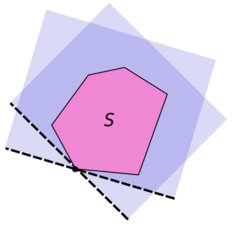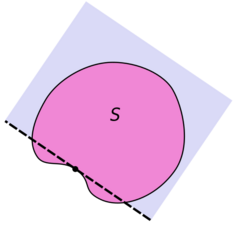Supporting hyperplane
 From HandWiki - Reading time: 3 min
From HandWiki - Reading time: 3 min

In geometry, a supporting hyperplane of a set
Here, a closed half-space is the half-space that includes the points within the hyperplane.
Supporting hyperplane theorem
This theorem states that if
defines a supporting hyperplane.[2]
Conversely, if
The hyperplane in the theorem may not be unique, as noticed in the second picture on the right. If the closed set
The supporting hyperplanes of convex sets are also called tac-planes or tac-hyperplanes.[3]
The forward direction can be proved as a special case of the separating hyperplane theorem (see the page for the proof). For the converse direction,
Define
Let
Let
See also
- Support function
- Supporting line (supporting hyperplanes in
Notes
- ↑ Luenberger, David G. (1969). Optimization by Vector Space Methods. New York: John Wiley & Sons. p. 133. ISBN 978-0-471-18117-0. https://books.google.com/books?id=lZU0CAH4RccC&pg=PA133.
- ↑ 2.0 2.1 Boyd, Stephen P.; Vandenberghe, Lieven (2004) (pdf). Convex Optimization. Cambridge University Press. pp. 50–51. ISBN 978-0-521-83378-3. https://web.stanford.edu/~boyd/cvxbook/bv_cvxbook.pdf#page=64. Retrieved October 15, 2011.
- ↑ Cassels, John W. S. (1997), An Introduction to the Geometry of Numbers, Springer Classics in Mathematics (reprint of 1959[3] and 1971 Springer-Verlag ed.), Springer-Verlag.
References & further reading
- Ostaszewski, Adam (1990). Advanced mathematical methods. Cambridge; New York: Cambridge University Press. p. 129. ISBN 0-521-28964-5. https://archive.org/details/advancedmathemat0000osta.
- Giaquinta, Mariano; Hildebrandt, Stefan (1996). Calculus of variations. Berlin; New York: Springer. p. 57. ISBN 3-540-50625-X.
- Goh, C. J.; Yang, X.Q. (2002). Duality in optimization and variational inequalities. London; New York: Taylor & Francis. p. 13. ISBN 0-415-27479-6.
- Soltan, V. (2021). Support and separation properties of convex sets in finite dimension. Extracta Math. Vol. 36, no. 2, 241-278.
 |
51 views | Status: cached on July 20 2024 04:42:15
↧ Download this article as ZWI file
 KSF
KSF

